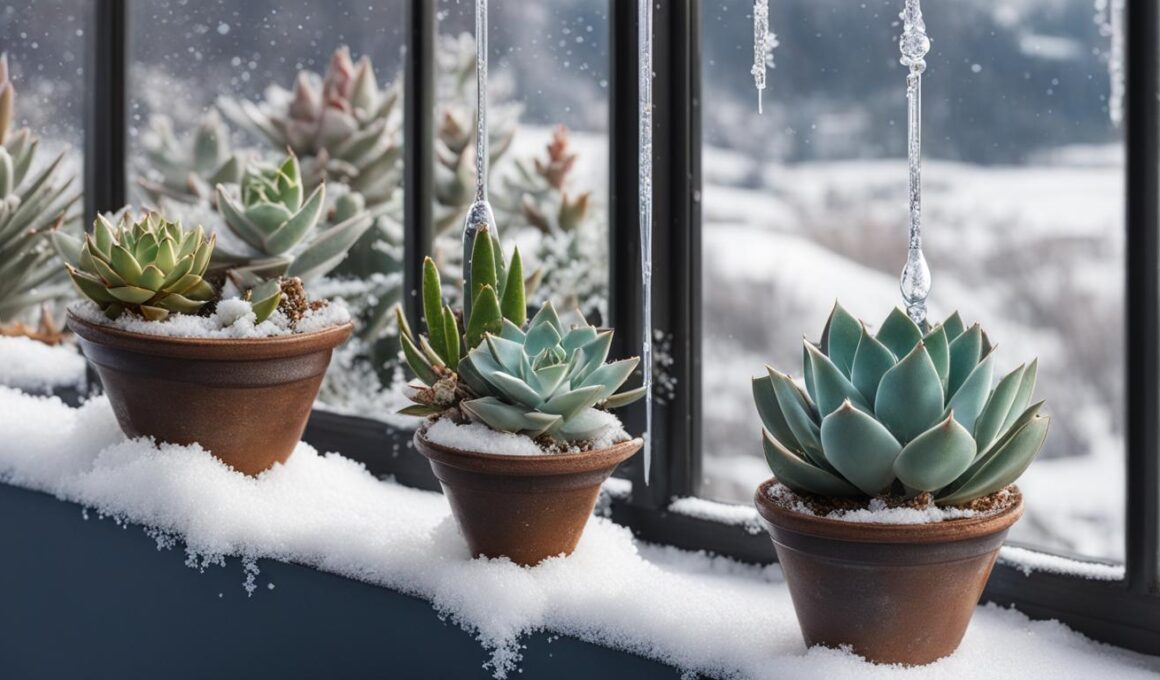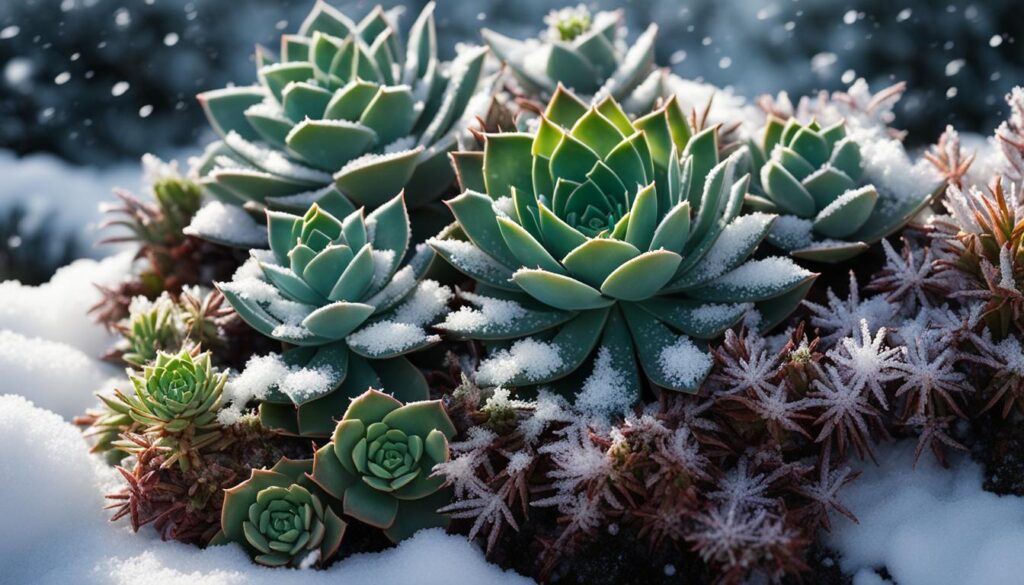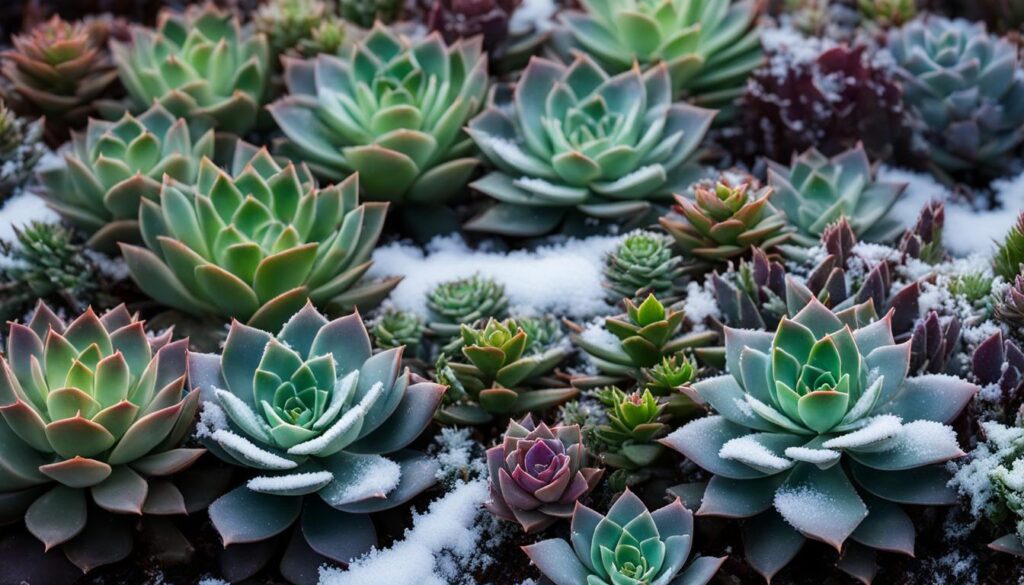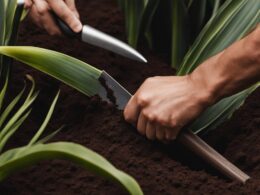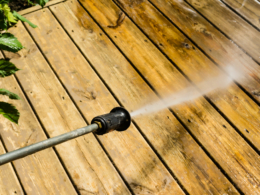When it comes to the temperature requirements of succulents, finding the right balance is crucial for their survival. Succulents, known for their ability to store water in their leaves and stems, are a popular choice for both indoor and outdoor gardens. However, they have specific temperature needs that should be taken into consideration to ensure their well-being.
Succulents can be categorized into two main types: hardy and soft succulents. The ideal temperature range differs for each type, with soft succulents being more sensitive to cold temperatures. Understanding how temperature affects succulents is essential for creating an environment where they can thrive.
Post Summary
- Succulents can be categorized into hardy and soft types, each with different temperature tolerance.
- Soft succulents cannot tolerate temperatures below freezing, while hardy succulents can handle temperatures as low as -20 degrees F.
- Cold temperatures can cause color changes in certain succulent species.
- Monitoring weather forecasts and providing protection is important to ensure the survival of succulents in different climates.
- Understanding the temperature requirements of succulents is crucial for their overall health and vitality.
Types of Succulents and Their Temperature Tolerance
When it comes to succulents, understanding the different types and their temperature tolerance is key to ensuring their survival and well-being. Succulents can be broadly categorized into two types: soft succulents and hardy succulents. Each type has its own specific temperature requirements and preferences.
Soft succulents, which make up the majority of available species, are sensitive to freezing temperatures and prefer to be in temperatures above 32 degrees F. These delicate succulents thrive in temperatures between 40 to 60 degrees F, making them well-suited for indoor or mild outdoor climates. Popular soft succulent species include Echeveria, Sedum, and Haworthia.
On the other hand, hardy succulents are more resilient and can tolerate much colder temperatures. They can withstand freezing temperatures and even thrive in climates as low as -20 degrees F. Hardy succulents, such as Sempervivum and certain Sedum species, are well-suited for colder regions and can add beauty and color to gardens even in freezing temperatures.
It is important to consider the specific needs of each succulent species when it comes to temperature tolerance. By providing the right temperature conditions for your succulents, you can create an environment that promotes their growth and ensures their overall health and vitality.
| Succulent Type | Temperature Tolerance |
|---|---|
| Soft Succulents | Above 32 degrees F; Ideal range: 40 to 60 degrees F |
| Hardy Succulents | Can tolerate freezing temperatures; Ideal range: -20 to 60 degrees F |
Effects of Cold on Succulents
Succulents, like all plants, are affected by cold temperatures. The impact of cold on succulents can vary depending on the species and their hardiness. Understanding the effects of cold on succulents is crucial for their care and maintenance. Here are some key points to consider:
- Dormancy: Some succulents may go into a dormant state in response to consistent cold temperatures. This is a natural mechanism that allows them to conserve energy and protect themselves from the cold. During dormancy, succulents may appear less active and their growth may slow down.
- Color Changes: Cold temperatures can also cause color changes in certain succulent species. As a response to stress, some succulents may develop vibrant colors, such as red or purple. These color changes can be visually appealing and add interest to your succulent collection.
- Freezing and Damage: Soft succulents, especially those that are not cold hardy, are susceptible to freezing and damage when exposed to temperatures below freezing. Freezing causes the water inside the plant cells to expand, leading to cell damage and eventually, plant death. It is essential to provide protection or bring soft succulents indoors during freezing temperatures.
- Adaptations: Certain succulents have developed adaptations to cope with cold temperatures. Cold hardy succulents, such as Sempervivum and Sedum species, are capable of withstanding freezing temperatures. These succulents have specialized tissues that can tolerate the formation of ice crystals and continue to thrive even in cold climates.
Cold Hardiness of Common Succulents
| Succulent Species | Cold Hardiness |
|---|---|
| Sempervivum | -20°F to -30°F |
| Sedum ‘Autumn Joy’ | -20°F to -30°F |
| Aloe vera | 25°F to 30°F |
| Echeveria | 30°F to 35°F |
Understanding the effects of cold on succulents and the specific requirements of different species will help you create a suitable environment for their growth and ensure their well-being. Whether it’s providing protection during freezing temperatures or selecting cold hardy varieties for your climate, taking these factors into consideration will contribute to the longevity and health of your succulents.
Color Changes in Succulents due to Cold
Cold temperatures can have a fascinating effect on the coloration of certain succulent species. When exposed to temperatures between 45 to 60 degrees F, soft succulents may undergo a striking change in color. Green succulents can turn pink or red, while purple succulents may become even darker in hue. These color changes are a response to the stress caused by cold temperatures and can add visual interest to your succulent collection.
To preserve the color of your succulents and prevent damage, it is important to monitor the weather forecast. If temperatures are expected to drop below freezing, provide protection by covering your succulents with a cloth or bringing them indoors. This will shield them from the cold and help maintain their vibrant colors.
Adding variety to your succulent collection can create a visually captivating display. By selecting succulents with different color-changing tendencies, you can create a dynamic arrangement that evolves with the seasons. Keep in mind that not all succulents will undergo color changes in response to cold temperatures, so make sure to research the specific species you are interested in.
The Relationship Between Temperature and Succulent Color
The color changes observed in succulents exposed to cold temperatures are due to physiological responses within the plants. As temperatures drop, certain pigments in the leaves and stems, such as anthocyanins, may become more prominent. These pigments often create shades of red, pink, or purple, resulting in a visually striking transformation.
| Succulent Species | Color Change |
|---|---|
| Echeveria ‘Lola’ | Green to pink |
| Sedum dasyphyllum | Green to red |
| Graptopetalum paraguayense | Green to purple |
It is important to note that the extent and intensity of color changes may vary among different succulent species and individual plants. Factors like genetics, light exposure, and overall plant health can influence the degree of color transformation. Therefore, while cold temperatures can contribute to color changes, they may not always guarantee the same vibrant results. Remember to provide your succulents with optimal growing conditions, including adequate sunlight and well-draining soil, to promote healthy growth and color development.
By understanding the relationship between temperature and succulent color changes, you can enhance the visual appeal of your succulent collection. Embrace the diversity of colors that cold temperatures can bring and enjoy the ever-changing beauty of your succulents throughout the seasons.
Cold Hardy Succulents
If you live in a colder climate, you’ll want to choose cold hardy succulents that can withstand freezing temperatures. These resilient plants are specially adapted to thrive in harsh conditions and can add beauty and interest to your garden even in colder months. Here are some popular cold hardy succulents that can withstand low temperatures:
Sempervivum
Sempervivum, also known as hens and chicks, is one of the most cold hardy succulents available. These plants form tight rosettes and come in a variety of colors, from green to red to purple. Sempervivum can tolerate temperatures as low as -20 degrees F and are an excellent choice for colder climates.
Sedum
Sedum is another group of succulents known for their ability to withstand colder temperatures. These plants have fleshy leaves and come in a wide range of shapes, sizes, and colors. Some popular cold hardy sedum varieties include Sedum spectabile (ice plant), Sedum rupestre (rock stonecrop), and Sedum spurium (two-row stonecrop).
| Succulent | Temperature Tolerance |
|---|---|
| Sempervivum | -20°F |
| Sedum spectabile | -30°F |
| Sedum rupestre | -20°F |
| Sedum spurium | -30°F |
When growing cold hardy succulents, it’s important to provide them with well-draining soil to avoid root rot. These plants also benefit from full sun exposure to encourage compact growth and vibrant colors. While they are more tolerant of cold temperatures, it’s still important to protect them from extreme weather conditions, such as frost or prolonged freezing temperatures.
By incorporating cold hardy succulents into your garden, you can enjoy the beauty of these unique plants throughout the year, even in colder climates. Their ability to withstand freezing temperatures makes them a great choice for gardeners looking to add texture, color, and interest to their outdoor spaces.
Best Temperature Ranges for Succulents
When it comes to maintaining the health and vitality of your succulents, providing them with the best temperature range is crucial. Succulents thrive in temperate climates with temperatures between 60 to 80 degrees Fahrenheit. This range allows them to grow and thrive without being subjected to extreme heat or cold. However, it is important to note that different succulent species have varying temperature preferences, so it’s essential to consider their specific needs.
While temperatures on the higher end of the range, up to 90 degrees Fahrenheit, can accentuate the colors of succulents, especially softer varieties, extreme heat above this threshold is not recommended as it can harm the plants. On the other hand, temperatures below 40 degrees Fahrenheit are also not ideal as they can cause damage, especially to soft succulents. It’s important to monitor the weather and provide protection when temperatures drop below freezing to ensure the survival of your succulents.
Factors to Consider
When determining the best temperature range for your succulents, there are a few factors to consider. Firstly, the type of succulent plays a significant role. Soft succulents, which make up the majority of available species, prefer temperatures above freezing and thrive in the range of 40 to 60 degrees Fahrenheit. Hardy succulents, on the other hand, are more resilient and can tolerate temperatures as low as -20 degrees Fahrenheit, making them suitable for colder climates.
Additionally, the location and climate you live in should be taken into account. If you reside in a region with extreme temperatures, such as desert areas with scorching summers or frigid winters, it’s important to provide extra care and protection for your succulents. This can include providing shade during hot summer days or moving them indoors during freezing temperatures in winter.
Summary
By providing succulents with the best temperature ranges, you are creating an environment that promotes their growth and overall health. Soft succulents thrive in temperatures between 40 to 60 degrees Fahrenheit, while hardy succulents can tolerate much lower temperatures. It’s important to monitor weather conditions, protect your succulents from extreme heat or cold, and consider the specific temperature preferences of different succulent species. With proper temperature management, your succulents will continue to flourish and bring beauty to your indoor or outdoor space.
Temperature Considerations in Summer
During the summer months, it’s important to consider the temperature needs of your succulents to ensure their well-being. High temperatures and intense sunlight can put stress on these plants, potentially leading to sunburn and damage. To protect your succulents from the scorching heat, it is recommended to take certain precautions.
Shade and Sun Protection
When temperatures rise above 80 degrees F, it is advisable to provide some shade for your succulents. You can relocate them to a shaded area, such as under a tree or patio, or create temporary shade using cloth or shade cloth. This will help to shield the plants from direct sunlight and reduce the risk of sunburn.
Planting Considerations
If you have potted succulents, it’s recommended to avoid using glass or metal containers during hot weather. These materials can absorb and retain heat, potentially overheating the plants’ roots. Opt for materials like concrete, terracotta, ceramic, or wood, which provide better insulation and airflow for the roots.
If you have the option, planting succulents directly in the ground can help regulate soil temperature and provide some natural insulation against temperature fluctuations. The soil acts as a buffer, protecting the roots from extreme heat and providing better moisture retention.
| Succulent | Optimal Temperature Range |
|---|---|
| Echeveria | 65-75°F |
| Haworthia | 70-80°F |
| Aloe | 70-80°F |
| Sedum | 65-75°F |
In addition to shade and planting considerations, it’s important to monitor your succulents for signs of heat stress. Look out for shriveling leaves, signs of wilting, or discoloration, as these may indicate that your plants are experiencing temperature-related issues. Providing adequate water and avoiding overwatering can also help the plants cope with hot weather conditions.
Remember, every succulent species has its own temperature preferences. By being aware of these considerations and taking appropriate measures, you can ensure the health and longevity of your succulents during the summer months.
Temperature Considerations in Winter
During the winter months, it is crucial to take special care of your succulents to ensure their survival and well-being. The cold temperatures can be harmful, especially for soft succulents that are sensitive to freezing temperatures. Here are some important temperature considerations to keep in mind:
Protecting from Frost
Succulents, especially soft varieties, can be susceptible to frost damage. It is essential to keep the temperature above freezing point to prevent harm. If you live in an area where temperatures drop below 40 degrees F, it is recommended to provide insulation for your succulents. You can cover them with cloth or bring them indoors overnight when frost is expected. This simple step can help safeguard your succulents from extreme cold and protect their delicate foliage.
Cold Hardy Succulents
Some succulents are more tolerant of colder temperatures than others. Cold hardy succulents, such as Sempervivum, can withstand frost and even enjoy cool temperatures between 30 to 40 degrees F. If you are looking to add succulents to your winter garden, consider choosing varieties known for their cold resistance. These succulents can thrive in colder climates and bring beauty to your outdoor space even during the chilly months.
| Succulent Variety | Cold Tolerance | Temperature Range |
|---|---|---|
| Sempervivum | High | 30 to 40 degrees F |
| Sedum | Moderate | 40 to 50 degrees F |
| Echeveria | Low | 50 to 60 degrees F |
Winter Watering
During the winter season, succulents require less water as they go through a period of dormancy. It is important to adjust your watering schedule accordingly to prevent overwatering. Succulents should be allowed to dry out between waterings, and the soil should be well-draining to avoid waterlogged roots. Keep a close eye on the moisture levels and adjust your watering routine based on the condition of the soil and the specific needs of your succulents.
By following these temperature considerations in winter, you can help your succulents thrive and survive the cold months. Paying attention to frost protection, selecting cold hardy varieties, and adjusting your watering practices will ensure the health and longevity of your precious succulent plants.
Planting Options for Different Climates
When it comes to planting succulents, it is essential to consider the climate and temperature conditions in your area. Different succulent species have varying temperature tolerances and require specific planting options to thrive. Whether you live in a cold climate or a region with extreme temperature fluctuations, here are some planting options to consider:
Cold Climates
If you reside in a colder climate with freezing temperatures, opting for cold hardy succulents is your best bet. These resilient succulents can withstand freezing temperatures and still thrive. Sempervivum and certain Sedum species are excellent choices for cold climates. Planting them directly in the ground provides natural insulation and helps protect them from extreme temperature fluctuations. If you prefer potted succulents, choose containers made of concrete, terracotta, ceramic, or wood, as these materials offer better insulation than glass or metal containers.
Hot and Dry Climates
In hot and arid climates, it is crucial to select succulents that can withstand intense heat and sunlight. Look for heat-tolerant succulent varieties such as Agave, Aloe, or Echeveria. These succulents have adaptations that allow them to store water and thrive in dry conditions. Planting them in well-draining soil and providing shade during the hottest parts of the day will help protect them from sunburn and heat stress. Choose containers made of materials that won’t overheat, such as light-colored plastic or pots with built-in saucers to retain moisture.
Humid Climates
If you live in a humid climate with high levels of moisture in the air, it is essential to select succulents that can tolerate these conditions. Some suitable options include certain varieties of Haworthia and Sansevieria. These succulents have adaptations that allow them to thrive in environments with higher humidity levels. Planting them in well-draining soil and providing adequate airflow will help prevent issues such as root rot. Using containers with drainage holes and placing them in areas with good air circulation is also beneficial for their health and longevity.
| Climate Type | Suitable Succulents | Planting Considerations |
|---|---|---|
| Cold Climates | Cold hardy succulents like Sempervivum and Sedum | Plant directly in the ground or use containers made of insulating materials |
| Hot and Dry Climates | Heat-tolerant succulents like Agave, Aloe, and Echeveria | Plant in well-draining soil and provide shade during the hottest parts of the day |
| Humid Climates | Succulents adapted to higher humidity levels like Haworthia and Sansevieria | Plant in well-draining soil and ensure adequate airflow to prevent root rot |
By selecting the right succulent species and considering the specific climate conditions in your area, you can create an ideal environment for these beautiful plants to thrive. Remember to provide appropriate watering, sunlight, and temperature conditions to ensure the health and longevity of your succulents.
Optimal Temperature Summary
When it comes to succulents, providing them with the optimal temperature range is crucial for their growth and well-being. Soft succulents, which make up the majority of available species, prefer temperatures above 32 degrees F. In contrast, hardy succulents can tolerate much lower temperatures, with some able to withstand as low as -20 degrees F.
Avoiding extreme temperatures is essential for maintaining healthy succulents. High temperatures above 90 degrees F can be detrimental to their growth, while temperatures below 40 degrees F can harm soft succulents. It is important to keep in mind that extreme heat can lead to sunburn, so providing shade or relocating succulents to a cooler area during the summer is advised.
During winter, succulents should be protected from frost damage. Soft succulents should be kept above freezing point, while cold-hardy species can tolerate cool temperatures between 30 to 40 degrees F. Insulating succulents with cloth or bringing them indoors during freezing weather can help safeguard them from cold-related stress and damage.
| Succulent Type | Optimal Temperature Range | Cold Tolerance |
|---|---|---|
| Soft Succulents | Above 32 degrees F | Cannot tolerate freezing temperatures |
| Hardy Succulents | 60 to 80 degrees F | Can tolerate temperatures as low as -20 degrees F |
When caring for succulents, keeping them within their optimal temperature range is crucial. Understanding the specific temperature preferences of different succulent species will help you create a suitable environment for their growth and ensure their longevity.
Conclusion
In conclusion, understanding the temperature requirements of succulents is crucial for their care and well-being. Soft succulents are sensitive to freezing temperatures and prefer temperatures above 32 degrees F, while hardy succulents can withstand much lower temperatures. By providing suitable temperature conditions and protecting succulents during winter, you can help them thrive and ensure their longevity.
It is important to monitor weather forecasts and take necessary precautions when temperatures drop below freezing. Soft succulents should be brought indoors or provided with adequate protection to prevent freezing and potential death. Hardy succulents, on the other hand, can tolerate colder climates and can be a great choice for those living in regions with freezing temperatures.
Color changes in succulents due to cold temperatures are a visually appealing response to stress. However, it is essential to preserve their color and prevent damage by monitoring temperature fluctuations and providing appropriate care. By understanding the specific temperature needs of different succulent species, you can create a favorable environment for their growth.
In summary, maintaining optimal temperature conditions for succulents, avoiding extreme heat or cold, and protecting them during winter are key factors in their overall health and vitality. By considering these temperature requirements, you can enjoy the beauty of succulents and ensure their long-term survival in your home or garden.
Will Succulents Survive in Cold Temperatures If They Are Growing in Shade?
Yes, succulents growing in shade can survive in cold temperatures. However, it’s important to choose cold-hardy succulent varieties and provide them with some protection during extreme cold snaps. Adding a layer of mulch around the plants can also help to insulate them from the cold.
FAQ
What temperature is too cold for succulents?
Soft succulents cannot tolerate temperatures below freezing, while hardy succulents can handle temperatures as low as -20 degrees F.
What types of succulents are there and what are their temperature tolerances?
Succulents can be categorized into two types: hardy and soft succulents. Soft succulents prefer temperatures above 32 degrees F, while hardy succulents can withstand much lower temperatures.
What are the effects of cold on succulents?
The impact of cold temperatures on succulents varies depending on the species and hardiness. Some may go dormant, while others may undergo color changes due to stress.
Do succulents change color when exposed to cold temperatures?
Yes, soft succulents exposed to temperatures between 45 to 60 degrees F may undergo a change in color, with green succulents turning pink or red, and purple succulents becoming darker.
What are cold hardy succulents?
Cold hardy succulents, such as Sempervivum and certain Sedum species, can tolerate temperatures as low as -20 degrees F and are suitable for colder climates.
What are the best temperature ranges for succulents?
The ideal temperature range for succulents is between 60 to 80 degrees F. Higher temperatures up to 90 degrees F can accentuate their colors, but extreme temperatures below 40 degrees F or above 90 degrees F are not recommended.
How should I consider temperature in summer?
During summer, succulents can be susceptible to sunburn if exposed to high temperatures and intense sunlight. It is recommended to provide shade or relocate them to a shaded area when temperatures rise above 80 degrees F.
How should I consider temperature in winter?
In winter, it is crucial to protect succulents from frost damage by keeping the temperature above freezing point. Soft succulents should be covered or brought indoors, while some cold hardy succulents can tolerate frost and enjoy cool temperatures between 30 to 40 degrees F.
What are the planting options for different climates?
In colder climates, it is advisable to choose cold hardy succulents and plant them directly in the ground to benefit from the natural insulation of the soil. When potted, materials like concrete, terracotta, ceramic, or wood provide better insulation than glass or metal containers.
What is the optimal temperature for succulents?
Succulents thrive in temperature ranges between 60 to 80 degrees F. Understanding the temperature needs of different succulent species is essential for their care and well-being.





